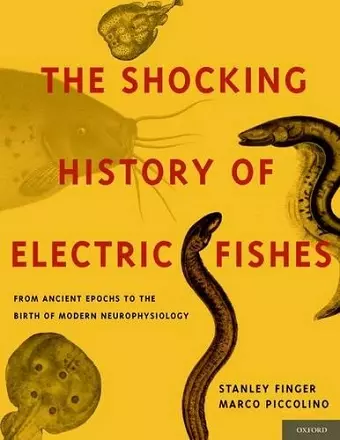The Shocking History of Electric Fishes
From Ancient Epochs to the Birth of Modern Neurophysiology
Stanley Finger author Marco Piccolino author
Format:Hardback
Publisher:Oxford University Press Inc
Published:8th Sep '11
Currently unavailable, and unfortunately no date known when it will be back

This book looks at how three kinds of strongly electric fishes literally became "electrical", and how they helped to change the sciences and medicine. These fishes are the flat torpedo rays common to the Mediterranean, the electric catfishes of Africa, and an "eel" from South America. The discovery of the electrical nature of these fishes in the second half of the 18th century was the starting point of the two fundamental advances in the sciences: on the physiological side, the demonstration that nerve conduction and muscle excitation are electrical phenomena, and on the physical side, the invention of the electric battery. Starting with catfish tomb drawings from Ancient Egypt and colorful descriptions of torpedoes from the Classical Era, the authors show how these fishes were both fascinating and mysterious to the ancients. After all, not only could they produce torpor and temporary numbness when touched, they could stun through intermediaries, such as wet nets and spears. Various explanations were given for these remarkable actions in ancient times, including the idea that they might release some sort of cold venom. Through the Renaissance, they also tended to be associated with occult and magical qualities. During the 1600s, natural philosophers speculated that rapid movements of specialized muscles could account for their actions. This idea was widely accepted until the 1750s, when the possibility that their shocks might be electrical began to be discussed. Showing how researchers set forth to provide support for fish electricity is a major focus of this book. Here the authors transport us into the jungles of South America and later show how some live eels were transported to London, where John Walsh demonstrated in1776 that they can actually spark. Subsequent chapters deal with further evidence for specialized fish electricity and how electric fishes helped to change ideas about even our own physiology. The authors also show how these fish remained a part of medicine, and how Volta modeled his revolutionary "pile" or electric battery on their anatomy. From beginning to end, this drama is firmly anchored in the philosophy and science of the day. Moreover, with biographical information about the key players, readers can fully appreciate what they were thinking as they tried to understand one of Nature's greatest puzzles - a mystery...
The book is more than a history of the electric fish; it is also a survey of the history of science, introducing all themes and approaches in this discipline in a relevant chronological sequence. This detailed work will be most useful to professional scientists/ historians in ichthyology neurobiology, and the history of the medical sciences. * CHOICE *
ISBN: 9780195366723
Dimensions: 279mm x 221mm x 33mm
Weight: 1746g
496 pages